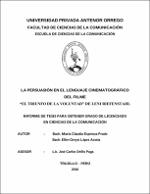Mostrar el registro sencillo del ítem
La persuasión en el lenguaje cinematográfico del filme “el triunfo de la voluntad“ de leni riefenstahl
| dc.contributor.advisor | Orillo Puga, Jose Carlos | |
| dc.contributor.author | Espinoza Prado, Maria Claudia | |
| dc.contributor.author | Lopez Acosta, Ellen Greysi | |
| dc.creator | Espinoza Prado, Maria Claudia | |
| dc.date.accessioned | 2017-04-10T15:52:05Z | |
| dc.date.available | 2017-04-10T15:52:05Z | |
| dc.date.issued | 2017 | |
| dc.identifier | T_COMU_552 | |
| dc.identifier.other | T046_47464509_T | |
| dc.identifier.other | T046_46353648_T | |
| dc.identifier.uri | https://hdl.handle.net/20.500.12759/2493 | |
| dc.description.abstract | Esta investigación pretende analizar la persuasión en el lenguaje cinematográfico del filme “El Triunfo de la Voluntad” de Leni Riefenstahl. Debido a la naturaleza propagandística del documental mencionado, se buscó analizar el lenguaje cinematográfico de éste a través de elementos de origen persuasivo como lo es la retórica y la teoría de la persuasión. A partir de ello se ha descubierto el uso de diferentes figuras retóricas y tipos de argumentaciones que han sido adjuntadas al cuadro de observación, en el cual también se enumeraron los tipos de elementos del lenguaje cinematográfico más representativos, estos se analizaron de forma denotativa y connotativamente. De la misma forma se estudiaron los tres discursos desarrollados por Adolf Hitler. | es_PE |
| dc.description.abstract | This research intends to analyze the persuasion in the cinematographic language of the film ““The Triumph of the Will““ of Leni Riefenstah. Due to the propagandistic nature of the mentioned documentary, we tried to analyze the cinematographic language of this one through element s of persuasive origin as it is the rhetoric and the theory of the persuasion. From this it has been discovered the use of different rhetorical figures and types of argumentations that have been attached to the picture of observation, which also listed the most representative types of cinematic language elements, these were analyzed denotatively and connotatively. In the same way the three speeches developed by Adolf Hitler were studied. When analyzing the results it was possible to conclude that the persuasion was developed in the film from a meticulous use of rhetorical figures, types of arguments and the theory of the persuasion. | en_US |
| dc.format | application/pdf | es_PE |
| dc.language.iso | spa | es_PE |
| dc.publisher | Universidad Privada Antenor Orrego | es_PE |
| dc.relation.ispartofseries | T_COMU_552 | |
| dc.rights | info:eu-repo/semantics/openAccess | es_PE |
| dc.rights.uri | https://creativecommons.org/licenses/by/4.0/ | es_PE |
| dc.source | Universidad Privada Antenor Orrego | es_PE |
| dc.source | Repositorio Institucional - UPAO | es_PE |
| dc.subject | Figuras Retoricas | es_PE |
| dc.subject | Lenguaje Cinematografico | es_PE |
| dc.title | La persuasión en el lenguaje cinematográfico del filme “el triunfo de la voluntad“ de leni riefenstahl | es_PE |
| dc.type | info:eu-repo/semantics/bachelorThesis | es_PE |
| thesis.degree.level | Título Profesional | es_PE |
| thesis.degree.grantor | Universidad Privada Antenor Orrego. Facultad de Ciencias de la Comunicación | es_PE |
| thesis.degree.name | Licenciado en Ciencias de la Comunicación | es_PE |
| thesis.degree.discipline | Ciencias de la Comunicación | es_PE |
| dc.subject.ocde | https://purl.org/pe-repo/ocde/ford#5.08.00 | es_PE |
| renati.type | https://purl.org/pe-repo/renati/type#tesis | es_PE |
| renati.level | https://purl.org/pe-repo/renati/level#tituloProfesional | es_PE |
| dc.publisher.country | PE | es_PE |


